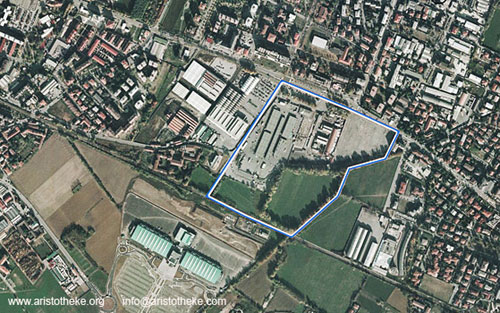COLUMNS
ARTI-PHYSIS
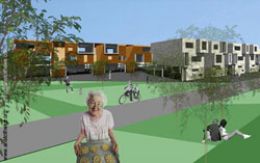
14 March, 2008
Stratifying Axialities> Celadina ReCelled (PART A)
The area of Celadina directly North of the rail tracks currently presents conditions of partial degradation, abandonment and improper land use.
Being occupied by a fruit and vegetable market, a former slaughterhouse, and the Fervet factories, a nonlieux (non-place) area is created. Due to the continual growth of the neighboring city of Seriate, this area assumes a character that is typical of a void compressed between two different urban systems. With the proposal of the new Bergamo-Seriate rail station at the South of the site, a need to recover the area is crucial.
PART A> (part B)
PROJECT DATA: The project is a Europan 8 Architectural Competition Entry in the Celadina district of the Italian town of Bergamo and concerns the urban recovery of an under-used city sector centrally located within the contemporary city core. Team Credits: Teamleader Aristotelis Dimitrakopoulos [Architect] Collaborators: Aungwara Nawacharoen Joe O’ Toole, Ricardo Lopez, Camila Ramirez [Architecture Students].
INTRODUCTION: The area of Celadina directly North of the rail tracks currently presents conditions of partial degradation, abandonment and improper land use. Being occupied by a fruit and vegetable market, a former slaughterhouse, and the Fervet factories, a nonlieux (non-place) area is created. Due to the continual growth of the neighboring city of Seriate, this area assumes a character that is typical of a void compressed between two different urban systems. With the proposal of the new Bergamo-Seriate rail station at the South of the site, a need to recover the area is crucial.
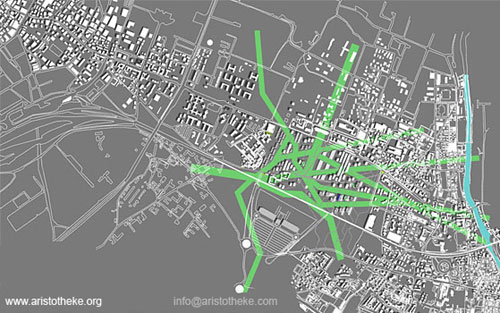
CIRCULATION: The project site is a totally unplanned slate with poor traffic connections to adjacent neighborhoods. As a first identification move, the traffic patterns were studied and new main through-roads were proposed, extending axes of the local fabric and establishing connections to the new and the unplanned motorways connecting to the adjacent convention facilities.
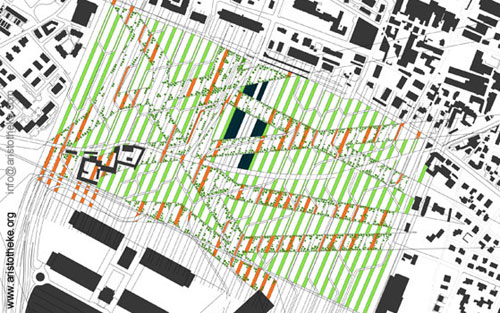
A LINKING DEVICE: The project concept is fundamentally about connectivity, about networks of multiple circulation modes operating at various scales - ranging from the simple neighborhood to the trans-regional. The site connects the surrounding city of Bergamo to a proposed regional multi-modal transportation hub, namely to the major highway node linking the city center to the national network, and to the train station which also receives passengers connecting from the nearby proposed airport. A system of primary and secondary streets for vehicular traffic and public transit, connecting north to south, acts as a filtration device, intended to disperse the volume of traffic and transition to streets and public spaces scaled for multiple use. The site becomes a vital mix of residential, commercial, leisure and civic uses layered with pedestrian and cycling networks and alternate modes of transportation. The reordering of hierarchies and flows gives prominence to pedestrian and cycling paths reorganizing the connected areas.
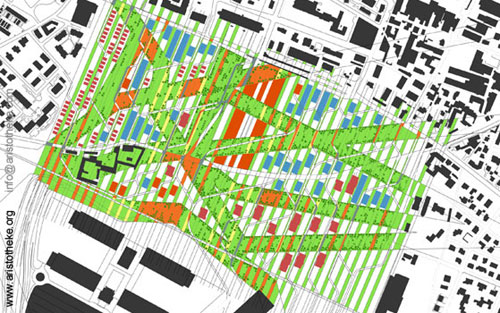
DOMESTI-SCAPE: Relating to the existing civic amenities and the planned sports facilities, the new development is understood as an open continuous parkland with distributed and varied qualities. This not to be translated as a utopian crescendo and does not sacrifice the operability of the site at an urban scale. The landscape scheme acts as the main infrastructure of the proposal creating a network of collective spaces of green and paved pedestrian areas, as open linear parks with communal meeting areas, sports fields; extensions of the private living spaces in close proximity. The site does not necessitate long recovery periods for soil recovery, therefore the initial stages of development focus on the implementation of the main landscape features. The key elements of the project become evident at the city context immediately, while each consecutive growth phase will reinforce and expand on these directives.
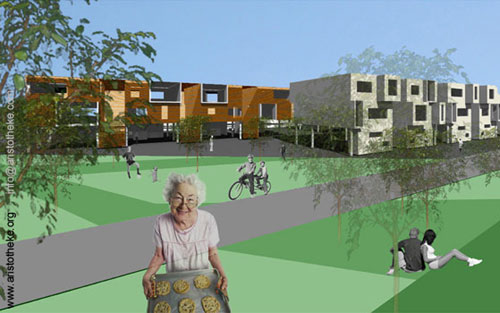
GREEN CATEGORIES: There are two primary species of landscape: the bands and the strips. The bands as the main landscape strata are striated by the thin parallel strips of varied materiality and/or vegetation: stone, brick or concrete pavers, dirt, grass, bushes, trees, flowers, taller plants, are categories of scaping both the strips and the bands. Through differentiation and layering, the distinction between these varied landscape categories becomes material.
BANDS: At the city scale, the seemingly randomly positioned zones act as green corridors primarily uninterrupted by automotive transportation. The positioning of the bands relates to nodal points within the city fabric, anchoring these main axes. Large continuous 'greenbelts' of open public areas articulated primarily through the dissecting landscaped strips provide an overlay of pathways for non-vehicular traffic. The traffic network follows the secondary north-south striation system that organizes building uses, parceling and public realms. Transit locations and cart paths for alternative fuel vehicles are embodied in the network. The points of intersection of these greenbelts with the city street network and the existing commercial activity become potentially new nodes for public gathering areas, commercial growth and circulation/transit transfer.
STRIPS: The system of strips is related to context influences. The linear patterns from existing industrial sheds and agricultural greenhouses generate a plateau of linear striation and imposed the basic axes of traffic movement. The dense road network acts as a mobility filtering system composed of quiet thru roads. This system of thin bands slices the whole site, defining simultaneously landscape patches and individual buildable lots, acting both as a visual organizational device and as a parceling plan. This becomes a flexible tool that performs at various stages of urban growth.
Aristotelis Dimitrakopoulos
Related articles:
- HORROR VACUI: JOSTLE, HUDDLE AND HELLENIC MODERNITY ( 21 June, 2005 )
- ATTIC ECTOPIA ( 16 November, 2012 )
- FRONTAGE SHOWCASES AND THE POST-URBAN UNCANNY-A RECTROACTIVE MANIFESTO FOR HELLENIC PROFESSIONAL SPACES ( 01 January, 2010 )
- VI: Unrecycling Cyclades. Part 1 ( 04 October, 2010 )
- Gwangju Asian Cultural Center, Korea – International Competition Entry, October ( 7 December, 2007 )
- De-institutionalizing Education: Notes on Academic Initiatives(i) ( 7 July, 2007 )
- HARBORING CAR-BAN-ITIES [Port Nord Organizational Protocols] ( 8 October, 2007 )
- Stratifying Axialities> Celadina ReCelled (PART B) ( 11 April, 2008 )
- FRAGMENTARY IMPUNITIES > VALLADOLID TRAJECTORIES (PART A') ( 5 September, 2008 )
- FRAGMENTARY IMPUNITIES > VALLADOLID TRAJECTORIES (PART B') ( 5 November, 2008 )
- SUBTERRA * SUPRATERRA ( 22 May, 2009 )
- VI: Unrecycling Cyclades. Part 2 ( 14 October, 2010 )
- Translocality as a Post-Native Narrative ( 16 February, 2011 )
- Metaxekisis : Re-Thinking the Athenian Court ( 08 December, 2010 )
- L-I*-THEKE ( 02 April, 2013 )
- House - glyptotheque - gallery - workshop ( 19 July, 2013 )
- Piloting Pilotis ( 31 December, 2013 )
- Escalteca of the Choetheque Series ( 01 April, 2014 )
- Schottheke of the Choetheque Series ( 01 June, 2014 )
- Floatheca Rh of the Choetheque Series ( 01 August, 2014 )
- Floatheca Sp of the Choetheque Series ( 26 September, 2014 )
- O-theke of the Choetheque Series ( 11 March, 2015 )
- Floatheca Cy of the Choetheque Series ( 03 January, 2015 )
- Ophthalteca ( 24 June, 2015 )
- Y-theca of the Choetheque Series ( 08 October, 2015 )
